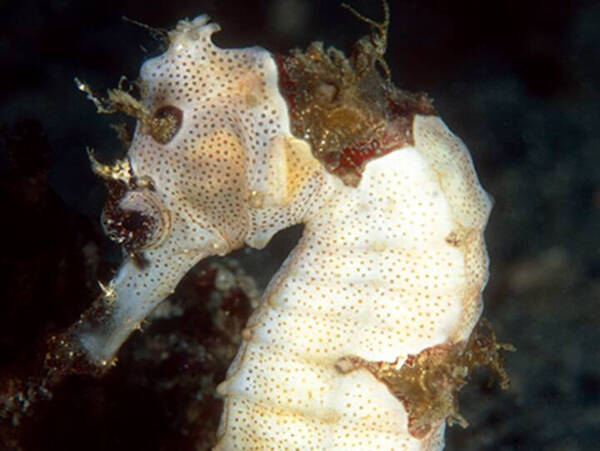Hippocampus kuda (scientific name: Hippocampus kuda), also known as Spotted Seahorse in foreign language, is an animal of Syngnathidae and genus Hippocampus.

Pipe seahorses often live in coastal bays, ports and lagoons, sandy sediments in rocky coastal areas, large algae and seagrass beds, mangroves, muddy bottoms and shallow reefs. They have strong adaptability and can tolerate changes in salinity. They often wrap their tails around seagrass, corals or rocks. They have poor swimming ability and their body color changes with the environment. It is carnivorous and feeds on invertebrates.
The breeding season of the seahorse is in spring and summer. The female fish lays eggs in the brooding pouch of the male fish, which is responsible for the care of the male fish. Its reproduction process is unique. During mating, the female transfers the eggs to the brooding pouch of the male seahorse. It is still unclear when fertilization occurs, but the fertilized zygotes will remain in the pouch for at least 4 to 5 weeks until the male seahorse ejects them.
Although the exact population size of the seahorse is still unknown, the seahorse trade survey project conducted between 1995 and 2000 gives us reason to suspect that the number of wild seahorses seems to be declining throughout its range. For example, in Thailand, 81% of fishers surveyed in 1998 and 1999 (30 of 37) and 71% of fishers in Malaysia (37 of 52) reported that seahorses, including the pipehorse, were declining in general (2010). Overfishing, an increase in the number of fishers, and indiscriminate fishing by trawlers are thought to be the causes of the decline (2010). In Hong Kong, China, there are reports that the local pipehorse was common 30 years ago, but has rarely been found since 2000 (2010). These examples suggest that population declines have been ongoing for more than 10 years (2010).

Preliminary genetic studies in Thailand suggest that there are two distinct populations in Thai waters: one in the Gulf of Thailand and another off the Andaman coast (Panithanarak et al. 2010). The population in the Gulf of Thailand shares common ancestry with other Pacific populations, while the population from the Andaman coast shares common ancestry with populations in the Indian Ocean and Indonesia.
In the Persian Gulf, the siphonophore is common on and around coral reefs; in Papua New Guinea and Indonesia, it is the most widespread and common seahorse; in the Indian Ocean off southern Africa, the siphonophore population is unknown.
The Australian population of the siphonophore was relocated in 1998 under the Australian Wildlife Conservation Act, and requires an export permit for trade. These permits are only granted for animals with an approved management plan or for animals bred in captivity. Such management was continued in 2001 under the new Environment Protection and Biodiversity Conservation Act. Many countries also have their own regulations on the capture and/or trade of siphonophores.
All seahorses are listed in Schedule I of the Indian Wildlife (Protection) Act, 1972, prohibiting their capture and trade. In 2011, Cambodia and China banned the export of wild seahorses. In Singapore, seahorses are considered threatened by habitat destruction and medicinal harvesting, and aquarium trade and harvesting are not allowed unless permission is obtained.
The seahorse is the largest species of seahorse with high medicinal value, and is also one of the finest species for artificial breeding. The determination of trace elements and amino acids in seahorses showed that seahorses contain a large amount of calcium, magnesium, potassium, sodium, iron, a relatively large amount of zinc, manganese, copper and a small amount of chromium, cobalt, selenium and lead. Seahorses are rich in a variety of essential amino acids for the human body, with a content of more than 4.0% of arginine, aspartic acid, alanine, glycine, proline and glutamic acid, and also contain taurine, which has a high medicinal value. Modern medical research shows that inorganic elements such as copper, manganese, and zinc have important physiological effects in enhancing human immune function, anti-aging, and strengthening the kidney and yang. Hippocampus contains more copper, manganese, zinc, and arginine, which may be an important material basis for its strengthening the kidney and yang.
Listed in the "Red List of Endangered Species of the World Conservation Union" (IUCN 2015 ver 3.1) - Vulnerable (VU).
Listed in the "Convention on International Trade in Endangered Species of Wild Fauna and Flora" (CITES) - Appendix II.
Listed in the "Red List of Chinese Species" - Endangered species.
Protect wild animals and stop eating game.
Maintaining ecological balance is everyone's responsibility!